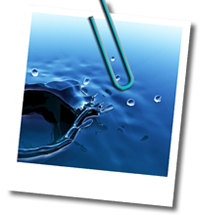
Nearly three quarters of the planet freshwater are contained in glaciers and ice fields; 97% of this amount is inaccessible for use. |
| CHAPTER 6. WATER |
Availability is not the only problem related to water. Water pollution is the other most important aspect, as it aggravates the scarcity problem. Surface and groundwater become polluted by the discharge of untreated municipal and industrial sewage water which, in addition to damaging natural ecosystems and affecting biodiversity, decreases or even prevents its use for human consumption. It is estimated that, in developing countries, nearly 90% of sewage water are discharged into rivers or other water bodies, with no previous treatment, leading to health problems: 80% of diseases in developing countries stem from polluted water, as well as the annual death of 2.2 million persons (50% of which are children under 5 years old) and 400 million cases of malaria (quoted by Carabias and Landa, 2005). Although the water subject has been focused mostly from the point of view of human needs, its importance as a key element for the proper functioning and maintenance of natural ecosystems and biodiversity is also worth stressing. In absence of water that warrants their functioning and maintenance, natural ecosystems become degraded, loose their biodiversity and hence stop providing (or reduce the quality of) the goods and environmental services they supply to today´s society. For all these reasons, humankind also faces, through the loss and alteration of ecosystems (caused by deforestation, surface and groundwater overexploitation and pollution, aquatic ecosystem degradation and fishing overexploitation, among other factors), water scarcity and pollution. The water subject is nowadays one of the key topics in the global environmental agenda. In addition to its importance for ecosystems and the maintenance of biodiversity, water is intimately related to social aspects associated to human health, food security and human safety, subsistence and socioeconomic development.
FRESHWATER IN THE WORLD World´s water resources It has been estimated that about one thousand 400 million cubic kilometers of water exist in the planet, only 2.5% of which are available as freshwater. This small percentage is located mostly in rivers, lakes, glaciers, ice fields and aquifers (Figure 6.1). Nearly 3 quarters of the planet’s freshwater is contained in glaciers and ice fields, 97% of which are inaccessible for use, since these are found in the Antarctica, the Arctic and Greenland. Continental glaciers, as well as ice fields and snow in mountain peaks represent a usable source of water, making these an important part of water resources in many countries.
Groundwater makes 96% of the planet unfrozen freshwater. This source is important as supply for creeks, springs and wetlands, as well as a basic resource to meet the water demand of many societies around the world. Although surface waters (that is lakes, dams, rivers, creeks and wetlands) retain a small percentage of the total freshwater resources in the Earth (0.3%), these represent nearly 80% of the surface water that is renewable each year. The world’s lakes store the largest volume of surface freshwater (91 thousand km3), over 40 times the volume present in rivers and creeks (2 120 km3) and approximately 9 times the water contained in swamps and wetlands. Also important is the water contained in the atmosphere which, although not representing a volume that can be compared to those mentioned above, is key for the role it plays in climate regulation.
|
